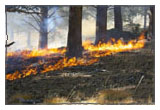| |
|
Fire has been an essential and natural part of the Rocky Mountain ecosystem for thousands of years. The presence
of fire within Rocky Mountain National Park is one of the significant factors contributing to the diversity and perpetuation of flora and fauna and
overall health of park ecosystems.
|
 |
 |
(enlarge image)
|
|
Fire naturally thins the forest, recycles nutrients into the soil, releases seeds for new plant growth, and creates
meadows. All of these are critical to forest health and natural cycles of growth and decomposition. Research in fire ecology has demonstrated that many
plant and animal species actually benefit from the rejuvenating effects of fires burning regularly through their habitat. Without fire, forests would not
be able to support the diverse habitats required by many plant, bird and mammal species.
|
 |
Despite the evidence that fire is a necessary element, over most of the past century people have feared and suppressed
it whenever possible. Lightning has always been, and still remains the primary cause of wildland fires. On average, Rocky Mountain National Park experiences
three to seven lightning caused fires per year. Other factors - including past logging practices, grazing levels and climatic conditions - have also contributed
to changes in natural fire regimes.
|
(enlarge image)
|
 |
|
As a result of this exclusion of fire, there has been an unnatural fuel buildup of live, dead and diseased trees, pine needles,
shrubs and grasses in some areas of the park. This accumulation of fuel now presents extreme hazards to the health of forests, soil, watersheds and wildlife. It also
is a primary concern to people living in these areas, as well as to the taxpayer that has to pay for the suppression costs of major wildfires.
|
|
Prescribed fire is the deliberate and carefully planned periodic burning of a selected site to reduce the risks of unnaturally heavy
fuel buildup, the potential for devastating wildfires and the loss of life and property. In order to help restore natural processes, land managers, including the National
Park Service, use prescribed fire as an important management tool. The National Park Service is also proactive in reducing hazardous fuel loads through manual removal of
fuel within the park's boundaries, especially in areas adjacent to private land and near park structures. Wildland fire use is the term used to describe naturally ignited
fires that are allowed to burn in certain areas under carefully monitored conditions to benefit park resources.
|

(enlarge image) |
|

(enlarge image) |
The overall program goal is to strengthen the concept of total fire management by working closely with neighboring landowners to reduce
the risks of wildfire, increasing the safe and effective use of prescribed fire, maintaining and utilizing strong fire suppression capabilities, and supporting mobilization of
resources to wildland fires. Firefighter and public safety are the highest priority in all fire management activities. Fire management is essential to protecting life and property,
and is vital to the mission of the National Park Service at Rocky Mountain National Park.
|
|
 |
|
|
|
 |
Plants and Animals
Environment and
Landscape
History and Culture
Research
Fire
Fire Information and Restrictions
Fire Management Actions
Employment
Links
to Fire Information Sources
Fire Photo Gallery
Alpine Hotshot Crew
Wilderness
Weekly Tidbit
|







